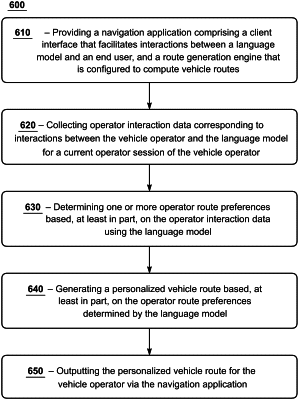| CPC G01C 21/3484 (2013.01) [G06N 3/0895 (2023.01)] | 16 Claims |

|
1. A method implemented via execution of computing instructions by one or more processors and stored on one or more non-transitory computer-readable storage devices, the method comprising:
providing a navigation application comprising:
a client interface that facilitates interactions between a language model and a vehicle operator; and
a route generation engine that is configured to compute vehicle routes;
collecting, by the language model, operator interaction data corresponding to the interactions between the vehicle operator and the language model for a planning or scheduling a vehicle route for a new or current operator session;
determining, by the language model, one or more operator route preferences for the vehicle route based, at least in part, on an analysis of the operator interaction data;
initiating a first communication exchange between the language model and the route generation engine to identify and personalize the vehicle route based, at least in part, on the operator route preferences determined by the language model for the new or current operator session; and
outputting, via the navigation application, the vehicle route for the new or current operator session to the vehicle operator;
wherein:
a second communication exchange between the language model and the vehicle operator enables the language model to collect feedback information that assists the language model in understanding or clarifying the operator route preferences, the feedback information is utilized to identify and personalize the vehicle route;
in connection with planning or scheduling the vehicle route for the new or current operator session, the language model selects a first personalized vehicle route from the plurality of personalized vehicle routes, and presents the first personalized vehicle route to the vehicle operator via the client interface for consideration;
in response to the vehicle operator providing a response to the language model denying the first personalized vehicle route, the language model requests the feedback information explaining why the first personalized vehicle route was denied;
in response to the vehicle operator providing the feedback information identifying a reason the first personalized vehicle route was denied, the language model updates the one or more operator route preferences for planning or schedule the vehicle route for the new or current operator session; and
the language model identifies and presents the vehicle operator with a second personalized vehicle route using the one or more operator route preferences updated with the feedback information.
|